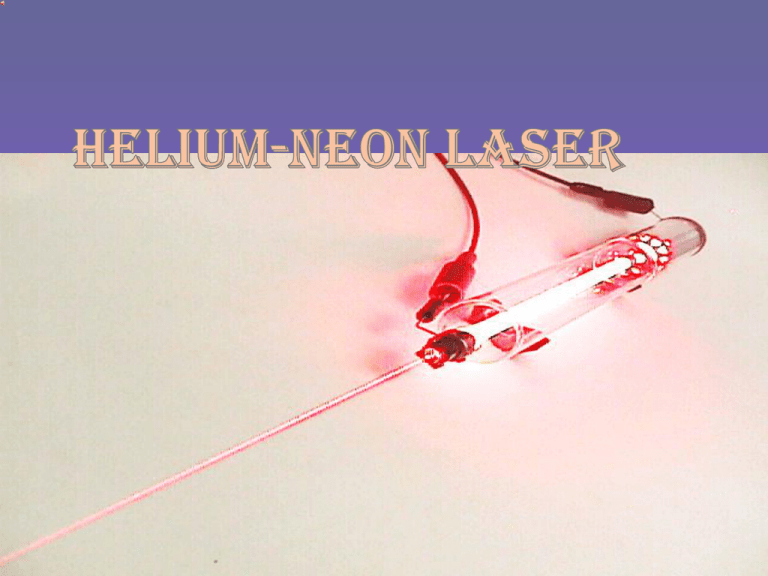Helium-neon laser
advertisement

Introduction • A helium-neon laser, usually called a He-Ne laser, is a • • • • type of small gas laser. HeNe lasers have many industrial and scientific uses, and are often used in laboratory demonstrations of optics. He-Ne laser is a four-level laser. Its usual operation wavelength is 632.8 nm, in the red portion of the visible spectrum. It operates in Continuous Working (CW) mode. The Helium-Neon laser was the first continuous laser. Construction of He-Ne laser • The setups consists of a discharge tube of length 80 cm and bore diameter of 1.5cm. • mixture of helium and neon gases, in approximately a 10:1 ratio, contained at low • • • pressure in a glass envelope. The energy or pump source of the laser is provided by a high voltage electrical discharge passed through the gas between electrodes (anode and cathode) within the tube. A DC current of 3 to 20 mA is typically required for CW operation. The optical cavity of the laser usually consists of two concave mirrors or one plane and one concave mirror, one having very high (typically 99.9%) reflectance and the output coupler mirror allowing approximately 1% transmission. Commercial HeNe lasers are relatively small devices, among gas lasers, having cavity lengths usually ranging from 15 cm to 50 cm (but sometimes up to about 1 meter to achieve the highest powers), and optical output power levels ranging from 0.5 to 50 mW. The mechanism producing population inversion and light amplification in a HeNe laser plasma originates with inelastic collision of energetic electrons with ground state helium atoms in the gas mixture. As shown in the accompanying energy level diagram, these collisions excite helium atoms from the ground state to higher energy excited states, among them the 23S1 and 21S0 long-lived metastable states. Because of a fortuitous near coincidence between the energy levels of the two He metastable states, and the 3s2 and 2s2 (Paschen notation) levels of neon, collisions between these helium metastable atoms and ground state neon atoms results in a selective and efficient transfer of excitation energy from the helium to neon. Construction of He-Ne laser • This excitation energy transfer process is given by the reaction equation: He*(23S1) + Ne1S0 → He(1S0) + Ne*2s2 + ΔE • The remaining step in utilizing optical amplification to create an optical oscillator is to place highly reflecting mirrors at each end of the amplifying medium so that a wave in a particular spatial mode will reflect back upon itself, gaining more power in each pass than is lost due to resulting in a stable continuous laser beam output through the front (typically 99% reflecting) mirror. • where (*) represents an excited state, and ΔE is the small energy difference between the energy states of the two atoms, of the order of 0.05 eV or 387 cm−1, which is supplied by kinetic energy Construction of He-Ne laser • The gain bandwidth of the HeNe laser is dominated by Doppler broadening rather than pressure broadening due to the low gas pressure, and is thus quite narrow: only about 1.5 GHz full width The visible output of the red HeNe laser, long coherence length, and its excellent spatial quality • Prior to the invention of cheap, abundant diode lasers, red HeNe lasers were widely used in barcode scanners at supermarket checkout counters. HeNe lasers are generally present in educational and research optical laboratories. • Energy level diagram of a HeNe laser Applications of He-Ne laser • The Narrow red beam of He-Ne laser is used in supermarkets to read bar codes. • Measuring distances • Red HeNe lasers have many industrial and scientific uses. They are widely used in laboratory demonstrations of optics in view of their relatively low cost and ease of operation compared to other visible lasers (however since about 1990 semiconductor lasers have offered a lower cost alternative for many such applications). • A consumer application of the red HeNe laser is the Laser Disc player, made by Pioneer. The laser is used in the device to read the optical disk. • guided “smart” weapons References – – – – – – – – – A.D. White and J.D. Rigden, "Continuous Gas Maser Operation in the Visible". Proc IRE vol. 50, p1697: July 1962. A. D. White, "Recollections of the First Continuous Visible Laser". Optics and Photonics News vol. 22, p34-39: October 2011. C. S. Willet "An Introduction to Gas Lasers" Pergamon Press 1974, pages 407–411. a b Niebauer, TM: Frequency stability measurements on polarization-stabilized He-Ne lasers, Applied Optics, 27(7) p.1285. a b Iodine-stabilized helium–neon laser at the NIST museum site. Javan, A., Bennett, W.R. and Herriott, D.R.: "Population Inversion and Continuous Optical Maser Oscillation in a Gas Discharge Containing a He-Ne Mixture". Phys. Rev. Lett. 63, 106– 110 (1961). Javan, A., Bennett, W. R. and Herriott, D. R.: "Population Inversion and Continuous Optical Maser Oscillation in a Gas Discharge Containing a He-Ne Mixture". Phys. Rev. Lett. 6 3, 106– 110 (1961). Notes on the Paschen notation. Sam's Laser FAQ. Thanks For Your Attention







